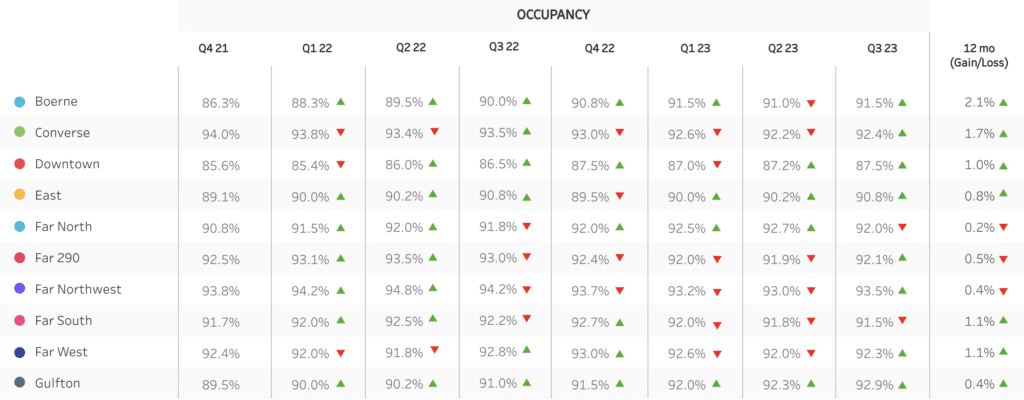3 Benefits of SMART Apartment Data Services

According to a 2019 American Housing Survey, multifamily living options, such as apartment buildings, townhouses, condominiums, and mixed-use developments, comprise approximately 31.4% of living spaces across America. However, despite this figure, there is a mass shortage of housing options, leading to a pressing need to build 4.3 million new apartments by 2035.
Within the multifamily industry, apartment data services are critical because such data allows multifamily investors to find appropriate properties. Given the significant role of the multifamily industry in America in providing more living options to the population, multifamily companies must use apartment data services for research and strategy purposes. But what exactly are they, and how do they benefit multifamily professionals?
Let’s guide you through the intricate details of apartment data services.
What are apartment data services? Apartment data services provide information on multifamily communities, rental rates, occupancy levels, amenities, and neighborhoods. The data is organized into clear, usable information so industry professionals can capitalize on the actionable insights with potential property opportunities.
What is the purpose of using apartment data services? Apartment data services provide reliable sources for industry professionals. They use the data to find market opportunities, streamline operations, improve workflow efficiency, and make informed decisions. In the multifamily industry, change is constant, making it essential for professionals to access reliable and updated information to stay competitive.
Which multifamily professionals use apartment data services? Due to the broad scope of apartment data services, they are used by multifamily professionals involved in managing, operating, and investing in multifamily properties, such as:
- Property managers use apartment data services to track property performance, such as occupancy rates, rental rates, and market surveys. This is particularly important as it offers property managers insight and transparency into their competitor’s activities. This allows them to utilize the data to stay competitive while making informed leasing and resident management decisions.
- Real estate investors utilize these services to assess property values, market trends, and potential acquisitions. It helps them make investment decisions based on accurate and up-to-date information.
- Leasing or real estate agents use the data to identify leads and prospective tenants, matching them with available units based on preferences and budgets.
- Asset managers oversee portfolios of multifamily properties. They use the data to monitor the performance of these properties, analyze financial data, and make decisions about improvements and divestitures.
- Developers use apartment data services to assess market demand, identify suitable locations for new construction, and determine the feasibility of new multifamily projects.
- Suppliers to the multifamily industry, such as maintenance service providers and technology vendors, also benefit from apartment data services. By understanding the market dynamics, occupancy trends, and property management needs, these suppliers can tailor their services and products to meet the specific demands of the multifamily sector.
Why are apartment data services necessary? Apartment data services improve workflow efficiency for industry professionals. Apartment data service providers ultimately remove the need for individuals to gather data manually, saving time and resources.
Additionally, apartment data service providers offer readily available data not typically accessible through online research. Therefore, gaining access to these reliable and updated insights gives the user the edge over their competitors.
Next, we will discuss how apartment data is gathered, analyzed, and used in the multifamily industry.
Understanding the Apartment Data Collection Process
Now that we better understand apartment data services, we will dive into how apartment data is collected and analyzed in the multifamily arena.
Below are five steps that apartment data service providers use to capture apartment data:

- Gather information: The first stage is to gather information by looking at relevant numbers and facts about apartment communities. This information is found on real estate websites, government records, or surveys. It usually includes information on how much apartments cost, how many are empty or occupied, what amenities they have, and details about the neighborhood.
- Clean the data: Next, the collected data must be cleaned. Raw data can be messy and full of mistakes. Therefore, it is cleaned to remove duplicated information, fix errors, and ensure the data is correct and current.
- Organize the data: Once cleaned, the data must be organized. This means categorizing the data, for example, according to location, price, or amenities.
- Make data-driven decisions: The final stage is for property investors and other industry professionals to use the gathered data to make strategic decisions. The data is organized into robust reports, allowing users to see which communities have the most potential. This allows multifamily professionals to make empowered decisions while expanding and growing their businesses within the industry.
Besides looking at how apartment data is collected and used, various types of apartment data exist in the multifamily industry. Let’s explore them below.
Types of apartment data
There is a broad scope of apartment data, which can be split into several categories. Some of the most common types of apartment data include:
- Property details: This includes detailed data on apartments and buildings, such as:
- Rental rates – This data tells us the market rate for a particular floor plan. It can include the average rental costs for a square foot, rental rate concessions, and price comparisons for different areas. This information is beneficial to property owners when evaluating potential rental rates.
- Occupancy levels – This data shows how many apartments are occupied or empty. High occupancy in multifamily properties means the community is stable and popular with residents, while low occupancy can indicate potential problems, such as undesirable locations or poor maintenance by investors.
- Amenities – These are the additional features offered to enhance the resident’s living experience, such as swimming pools, gyms, or pet-friendly policies. This data shows the available amenities, vital for renters looking for specific features. This information is utilized by multifamily professionals and property owners who want to attract tenants with appealing amenities.
- Ownership records – Understanding property ownership is vital information investors and other industry professionals will seek. For example, an investor may prefer to act without the intermediary party, in this case, the management company, and instead choose to speak directly with the property owner, saving them time while improving workflow efficiency.
- Management portfolios: This data type provides insight into management companies. It indicates the number of properties, units managed, housing type, build type, acquisitions, dispositions, and C-Suite personnel to identify potential leads.
- Market trends: This data shows current and historical details of the multifamily industry. It shows trends like the average rental rates within a market or submarket, concessions, and year of construction. This information is precious for investors because it allows them to evaluate historical trends, ultimately guiding them toward making data-driven decisions.

Knowing how to gather and understand this apartment data is essential. Whether you’re an investor looking for the perfect property or a sales representative looking for new leads, understanding these data categories will help you make strategic decisions.
Reach out to us to unlock the most comprehensive source of multifamily data and elevate your business insights.
3 Reasons To Use SMART Apartment Data Software
While technological advances are reshaping the multifamily industry, it is important to note a driving force behind using reputable apartment data providers like SMART Apartment Data, is the added benefit of streamlined processes and improved efficiency.
Imagine being able to find the perfect multifamily community effortlessly. With the SMART Apartment Data services, multifamily professionals can search for properties that meet their criteria and assess property performances based on our reliable apartment data and insights.
If multifamily professionals want to maximize the true value of apartment data providers like SMART Apartment Data, below are three reasons why industry professionals use our data to improve their decision-making process.
1. Streamline workflow efficiency

SMART Apartment Data helps multifamily professionals automate and streamline data gathering, analysis, and access.
Gone are the days of manually gathering data, which is inefficient and time-consuming. Instead, multifamily professionals can use our apartment data via a desktop or mobile app whenever needed. This provides valuable data at their fingertips, allowing them to target their niche, find potential leads, and filter unwanted noise.
2. Access updated, reliable data
One of the biggest advantages of using SMART Apartment Data services is the accessibility of reliable data. Traditional data collection often resulted in outdated information, leading to missed opportunities or uninformed decisions.
Rest easy knowing our skilled professionals meticulously research and update our data every 30 days, providing you with the most accurate insights. This timeliness is vital for staying competitive, identifying optimal locations, and predicting industry trends that impact property values.
Furthermore, SMART Apartment Data’s dataset prominently displays two critical dates: when the data was initially researched and when any change was last logged. This distinction is crucial, as not all research leads to a change in the existing data. By providing both dates, we ensure that our clients can distinguish between newly acquired information and data that has been confirmed as still accurate.
3. Leverage advanced analytics reports
Another reason the SMART Apartment Data platform is popular among multifamily professionals is the advanced data analytics and robust reports. The SMART Apartment Data software has cutting-edge technologies that filter and pinpoint historical data and trends. This allows users to leverage the data whenever needed and stay one step ahead of the competition.
Furthermore, the data available on the SMART Apartment Data platform is already curated into interactive reports that are easily digestible. Using visually appealing graphs that capture the raw data and rich results ensures a granular analysis of properties in the market. This reduces the time users spend on manually generating reports, saving them time and money.
The Benefits of Using Apartment Data Services
SMART Apartment Data Services is a beacon of change as the multifamily landscape transforms. We’re not just part of the game; we’re changing it, one dataset at a time. The benefits of SMART Apartment Data are nothing short of revolutionary, steering the industry toward a brighter and more informed future.
Let’s highlight the most significant benefits of using SMART Apartment Data’s software and tools.

- Precision like never before – With meticulously refined data, multifamily professionals can filter, search, and analyze appropriate properties whenever needed.
- Reliable data at your fingertips – Regular updates are invaluable in a market where change can happen overnight. Our 30-day updates empower multifamily professionals to make decisions on the fly, adjust strategies as needed, and respond quickly to market fluctuations, thereby staying ahead of the competition.
- Utilize historical data – SMART Apartment Data allows users to evaluate historical data to better understand past and current market conditions. This allows them to predict future trends and plan for long-term success.
SMART Apartment Data Services offers an unparalleled trifecta: precision, timeliness, and foresight. We’ve transformed the multifamily industry by providing access to real-time data to react to changes and shape the market proactively. As this revolution unfolds, we expect to see more innovative uses of SMART Apartment Data.
Explore the latest trends in multifamily data and analytics by reading our blog, or simply get started with our tailored data solutions for your business.
Ready to close more deals and exceed sales goals?
Meet with a data expert and discover how Smart connects companies like yours with industry leaders.
Related articles
Proud members of












